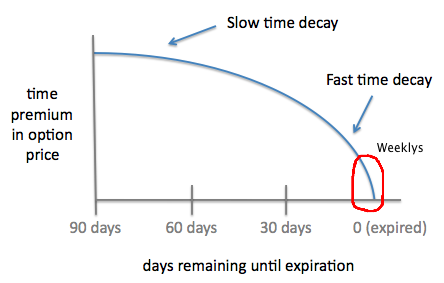Definition of Weekly Options
Weekly Options Time Decay
Weekly Option Example
Related Terms:
Definition of Weekly Options
Weekly Options are just like regular monthly options except that they expire every Friday instead of every month. When options first started trading in 1973, they were offered in monthly expirations, with each one expiring on the Saturday after the 3rd Friday of the month. In 2005 the CBOE introduced weekly options, which started trading on a Thursday and expired 8 days later on a Friday.
Weekly options (or "weeklys" as they have become known) are very popular. As a result, the CBOE increased the number of weeklys available, and it is now possible to have 5 or 6 weeks worth of weeklys available at any given time. In addition, the number of underlying securities that offer weeklys has increased from just a handful in 2005 to over 350 in 2015. You can see the whole list here.

Time Decay Of Weeklys
Because the final days of an option's life offer the fastest time decay, weeklys are popular with investors who like to collect premium (ie covered call investors, naked put writers, and others). They can sell an option with 8 days (or less) until expiration, wait for it to expire, and then do it again, potentially as many as 52 times per year.
Example of a "Weekly Option"
Let's say today is Thursday, March 26, and let's say you like Apple (AAPL) stock. If you look up the monthly options available you will find expiration dates of:
- Apr 17 (21 days from now)
- May 15 (49 days)
- Jun 19 (84 days)
- Jul 17 (112 days)
- etc... (every 3rd Friday of each month)
But many of those are a long ways away from today and who knows what could happy to AAPL, or the market, between now and then. Instead, look at the weekly expiration dates currently available and you'll find:
- Mar 27 (1 day)
- Apr 2 (7 days, 1 day off because of holiday)
- Apr 10 (15 days)
- Apr 17 (21 days)
- Apr 24 (29 days)
- May 1 (36 days)
That kind of fine grain control gives investors the chance to target a specific date (earnings date, ex-div date, new product date, etc) with much greater accuracy. And premium sellers can take advantage of the rapid time decay at the end of an option's life, avoiding the flat part of the time decay curve.
Now that you know the basics, keep reading to get some specifics about calls and puts:

Here are the top 10 option concepts you should understand before making your first real trade: